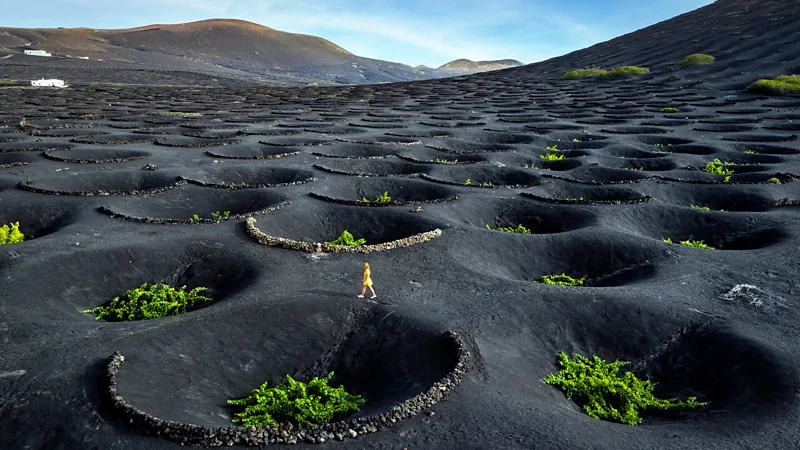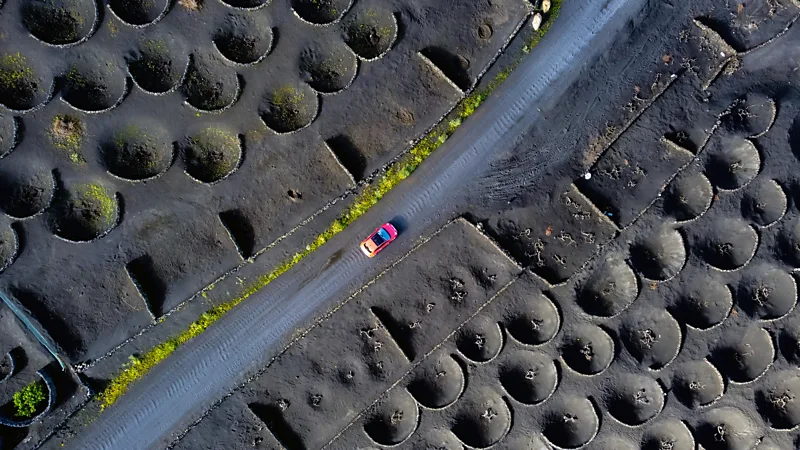The ingenious wines birthed from black volcanic craters
 In Spain's Lanzarote Island, vineyards nestled within conical hollows carved into layers of volcanic ash represent a testament to generations of innovation and perseverance.
In Spain's Lanzarote Island, vineyards nestled within conical hollows carved into layers of volcanic ash represent a testament to generations of innovation and perseverance.
From a distance, Lanzarote's vineyards appear stark against the jet-black terrain, punctuated by conical hollows that resemble the imprints of a mythical giant's thumb pressed into the earth. Yet, upon closer inspection, each crater reveals a thriving vine at its core.
Situated just 127km from Africa, Lanzarote is the easternmost of the Canary Islands, renowned for its volcanic landscape. Despite being among a group of fiery neighbors, it stands out as "Volcano Island," boasting over 300 lava spewers. The terrain, often likened to the lunar surface, offers a glimpse of what Earth may have looked like in a primordial state.
The eruptions of Timanfaya National Park in 1730, lasting six years and culminating in 1824, reshaped life on the island. Devastating villages and triggering famine, the eruptions also left behind a thick layer of volcanic ash known as picón.
While wine production has been a tradition in the Canary Islands since the 15th century, Lanzarote initially only produced wine for personal consumption, unlike its neighbor Tenerife, which found favor with English consumers. However, following the eruptions of 1730, Lanzarote's residents faced the challenge of adapting to their altered landscape.
For those who remained, necessity spurred innovation. Digging through the picón by hand, they discovered that their soil, though unsuitable for traditional crops, was surprisingly conducive to grapevines. The volcanic ash, once dreaded for its destructive effects, became the secret ingredient in Lanzarote's unique winemaking process.
Ingenious Solutions in Lanzarote's Wine Region
Lanzarote's wine region faces unique challenges, with only about 150mm of annual rainfall and frequent buffeting by intense trade winds and dust storms known as calima. Despite these adversities, farmers have devised innovative solutions to cultivate grapes and produce wine.
Nereida Pérez, the technical coordinator of Lanzarote wines' regulatory council, explains that farmers responded to the volcanic ash-covered fields by digging hoyos, or conical hollows, and planting grapevines within them. These hoyos, three meters wide by three to four meters deep, are covered with a layer of picón (volcanic ash) and bordered by low semi-circular walls made from lava stones.
This ingenious engineering allows the conical shape to collect sparse rain and dew, channeling water to the roots of the vines. Additionally, the picón draws moisture from the air and regulates soil temperature. The walls protect the vines from winds and prevent erosion, ensuring the survival of the vineyard.
Elisa Ludeña, the technical director of El Grifo, the oldest winery in the Canaries established in 1775, praises the visionaries who adapted to the challenging conditions. Their capacity to innovate has transformed Lanzarote's landscape into a thriving wine region, showcasing resilience and creativity in the face of adversity.
Unique Grape Varieties and Winemaking Conditions in Lanzarote
 Lanzarote's wine production is dominated by the Malvasía Volcánica grape, a white variety exclusive to the Canary Islands and primarily cultivated on the island, comprising 60% of its wine output. Other varieties include Listán Blanco, Vijariego Blanco, Moscatel de Alejandría, Listán Negro, and Syrah. Remarkably, some vines on the island are nearly two centuries old, as Lanzarote's vineyards were spared from the phylloxera infestation that devastated European wineries in the 1800s.
Lanzarote's wine production is dominated by the Malvasía Volcánica grape, a white variety exclusive to the Canary Islands and primarily cultivated on the island, comprising 60% of its wine output. Other varieties include Listán Blanco, Vijariego Blanco, Moscatel de Alejandría, Listán Negro, and Syrah. Remarkably, some vines on the island are nearly two centuries old, as Lanzarote's vineyards were spared from the phylloxera infestation that devastated European wineries in the 1800s.
Despite its location near the 30th parallel north, Lanzarote's unique landscape and persistent winds contribute to the production of quality wines. The sandy volcanic soils are inhospitable to phylloxera, and the island's semi-desert climate, coupled with the controlling influence of the winds, helps maintain the health of the grapevines.
Josep Roca, an award-winning sommelier, notes the bold acidity and fresh character of Lanzarote's best white wines, featuring nuances of green apple, lime, jasmine, and orange blossoms. While some attribute a minerality to volcanic wines, Roca emphasizes that it is not directly derived from minerals in the soil but rather from microorganisms and fermentation processes. Nevertheless, the volcanic soil imparts a distinct texture to the wines, contributing to their crispness, balance, and easy-drinking nature.
Handcrafted Vineyard Work and Generational Shifts in Lanzarote's Wine Industry
 In Lanzarote's vineyards, manual labor is essential, with workers carefully navigating narrow paths to avoid destabilizing the conical hoyo structures. Harvesting begins in late July, with grapes collected by hand in small crates amidst temperatures reaching 27°C. Nereida Pérez describes the laborious process of carrying crates of grapes across the vineyards repeatedly, highlighting the physical demands faced by growers.
In Lanzarote's vineyards, manual labor is essential, with workers carefully navigating narrow paths to avoid destabilizing the conical hoyo structures. Harvesting begins in late July, with grapes collected by hand in small crates amidst temperatures reaching 27°C. Nereida Pérez describes the laborious process of carrying crates of grapes across the vineyards repeatedly, highlighting the physical demands faced by growers.
El Grifo and Bodegas Los Bermejos, among others, emphasize the importance of meticulous vineyard management in producing high-quality wines. El Grifo's single-vineyard wine, Finca Ramón, pays tribute to a dedicated grower, reflecting the significance of individual vineyard plots. Daniel Martín, a young winemaker at Bodegas Los Bermejos, emphasizes the dedication and sacrifice of grape growers, acknowledging the challenging nature of their work.
Despite the aging demographic of Lanzarote's grape growers, a new generation of winemakers like Martín and Ludeña are optimistic about the industry's future. They believe that increased investment in grape prices and the allure of winemaking will attract more young people to farming grapes on the island.
However, Lanzarote's wine industry faces ongoing challenges, including climate change and water scarcity. Despite these obstacles, the resilience of Lanzarote's vineyards serves as a source of inspiration, highlighting the determination of grapevines to thrive under adverse conditions.








































